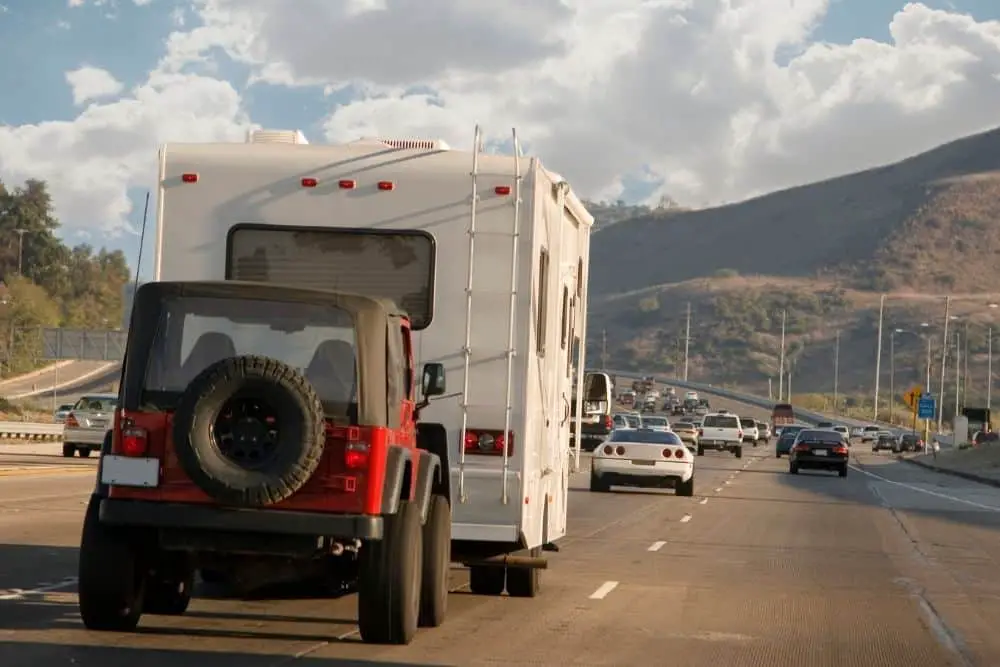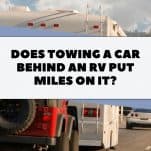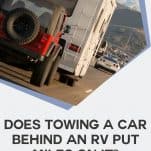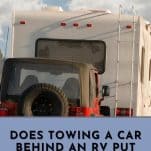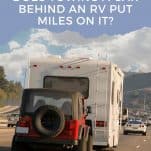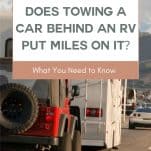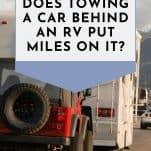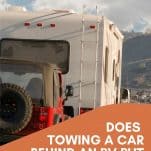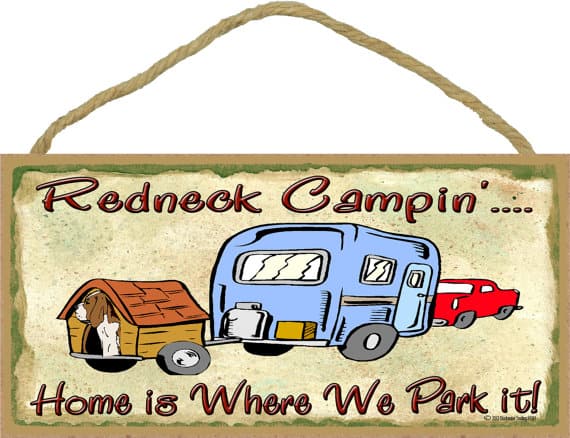The odometer on newer kinds of cars will not show the number of miles driven because it’s electric and relies upon motion from transmission. However, older vehicles with mechanical odometers can still record those same numbers as before since their wheels keep spinning no matter what!
In order to choose your towing vehicle, you’ll need to understand why certain seasoned RV owners insist on certain features.
Dolly Towing Vs. Flat Towing
When towing a car behind an RV, it’s important to know the difference between dolly and flat towing.
Dolly Towing
Using an RV tow dolly is the first option for towing a car behind an RV. As its name suggests, a tow dolly is a compact, two-wheeled trailer designed to tow a car’s front wheels while the rear wheels stay on the road.
When towing an RV, a tow dolly is normally attached via a trailer hitch. Drive your car’s front wheels onto a tow dolly and secure them in place with a set of specially-designed straps. Your vehicle’s rear wheels will stay on the ground.
Flat Towing Behind An RV
“Flat towing” is another popular method of pulling an automobile behind an RV. “Four wheels down” towing (also known as “flat towing”) is the practice of using a tow bar attached to the towed car and permitting it to roll behind the RV.
Does Flat Towing Add Miles To The Odometer?
Towing a vehicle can wear down various components, but it does not affect the odometer. The tires will continue turning and moving as before which causes them to suffer from wear just like in normal use.
The idea that you have to drive for miles on the road before your odometer starts counting is a common misconception among many people. With the installation of electronic odometers in all new cars, drivers can no longer check their speed by looking at an old-fashioned mechanical device. The numbers are calculated from transmission gear and not on wheels
Many RV enthusiasts have vehicles with little or no mileage, but they’ve been driven differently than a typical vehicle would be. This has resulted in owners owning cars that barely get used and often come equipped with newer sets of tires and engines that are scarcely been used.
Things get more challenging when towing an all-wheel-drive vehicle. In most cases, the amount of concern will be determined by the transmission and the transfer case while the vehicle is on the ground.
Towing a transfer case for long distances or at highway speeds without shifting into 2-wheel or 4-wheel drive-hi is not recommended. Removing the rear drive shaft and towing a vehicle with its back wheels on the ground is the safest option for towing 4-wheel drive or all-wheel drive vehicles.
Does Using A Tow Dolly Add Miles To Your Car?
Using a towing dolly that just raises the vehicle’s front wheels minimizes the amount of stress on the vehicle’s rear tires, making it marginally better for the vehicle’s performance.. To put it another way, with a front-wheel drive car, only the wheels actually move because there’s no actual drivetrain involved.
Having a smaller car will have little to no impact on your RV’s mileage, hence it is suggested that you do so. In contrast, tiny vehicles are nearly always front-wheel-drive and are ideal for protecting your vehicle from excessive wear and tear.
In addition, a growing number of car manufacturers are producing smaller SUVs with front-wheel drive. This is an excellent alternative for those who want to enjoy driving but don’t need the space or capability that larger vehicles offer!
When Does Towing Not Add Damage To Your Car?
Trailers known as car haulers typically feature two axles for stability and low (or no) rails around the perimeter.
If your car is completely on a trailer with all 4 wheels, there is nothing moving so nothing will get damaged.
The latter technology allows you the ability to operate the trailer’s brakes from within your RV, rather than relying on the trailer’s pressure against a hydraulic cylinder (surge brake).
The cost of purchasing and installing a brake controller for your RV is approximately $300 if it doesn’t have one installed already. In addition, your automobile hauler will need to be licensed, so this will be an extra cost.
After arriving at your site, you may have to disconnect the trailer and store it somewhere in the campsite. Make sure you look for a “pull-through” campsite that is long enough if you want to avoid this.
Why Does Towing A Car Not Add Miles To It?
Before the introduction of electric odometers, everything was mechanical. A regular odometer would count up if your wheels were moving in a forward direction; they would also decrease when going backward!
The electronic odometers in vehicles started becoming the norm starting in the early part of the 1990s. The odometers on most cars are powered by electricity. They require an input of varying degrees of movement from the gearbox, which means that any movement will count towards your total number of miles traveled!
No power is flowing into or out of the car’s electric odometer while the key is either off or the radio is turned on. Because of this, while the car is being towed, the odometer does not register any miles.
Does It Matter What Gear The Car Is In?
It doesn’t matter if it’s in gear or not if it’s firmly attached to the trailer. There is a small amount of resistance to rolling off whether you leave it in gear or in neutral, but neither of these matters provided the vehicle is firmly fastened down.
Car frames should be fastened to the trailer to prevent them from swaying while being towed. As a result, the vehicle and trailer move together as a single unit, with the trailer springs acting as the only springs. In order to keep the trailer and the automobile body from bouncing about, you must tie them down by the wheels.
Ideally, you’d block up the frame so that you’re not bottoming out the car’s suspension when you tie it down (assuming you do cinch it down absolutely tight) or allowing room for half of the suspension movement and the straps falling slack when you hit a bump. As a result, (if you don’t cinch the belt all the way)
If you are flat towing, then the car should be kept in neutral.
When Can You Tow A Car Behind An RV?
This is something to keep in mind before buying the vehicle you plan to pull behind your RV. Towing an automated car, for example, necessitates that the vehicle’s driven wheels remain stationary.
In the wake of a car breakdown, flatbed tow trucks are now the preferred method of transportation. Transmissions that use torque converters to shift ratios while the vehicle is being towed can be severely damaged when the wheels spin.
Because RV towing is so prevalent only in the United States, the majority of cars built in the country are equipped with towing-specific settings. There are usually a few vehicles at the dealership that are already equipped to be towed when you buy your vehicle.
How Do You Tow A Vehicle With All Four Wheels On The Ground?
There are special dollies that attach to the front wheels of the vehicle to be towed by an RV. When towing a car behind a camper van or other recreational vehicle, these systems allow the vehicle to be hauled in the same manner as a trailer.
Once the vehicle’s steering wheel is locked in this position, it cannot be turned left or right. There is no need to worry about towing an RV with a vehicle that is constantly changing directions because the automobile follows in the RV’s footsteps.
In most cases, the car will need to be in neutral, since the tires will have to be moving freely, with no brakes applied. It’s a great idea to think of the car as an extension of the RV, rather than a distinct vehicle with its own engine and velocity.
Cars like the Ford Escape and Jeep Wrangler are ideal for towing behind a recreational vehicle (RV).
In Conclusion
A modern vehicle’s odometer will not move while it is being towed, but it will wear and tear the vehicle’s moving parts. The amount of wear and tear you experience in your vehicle will be strongly influenced by your vehicle selection, with smaller vehicles seeing less wear and tear.

